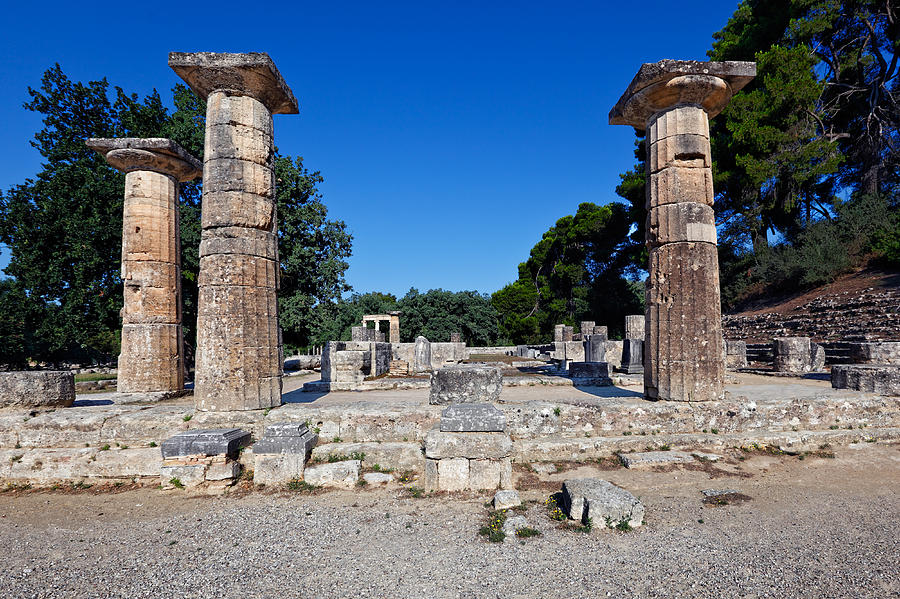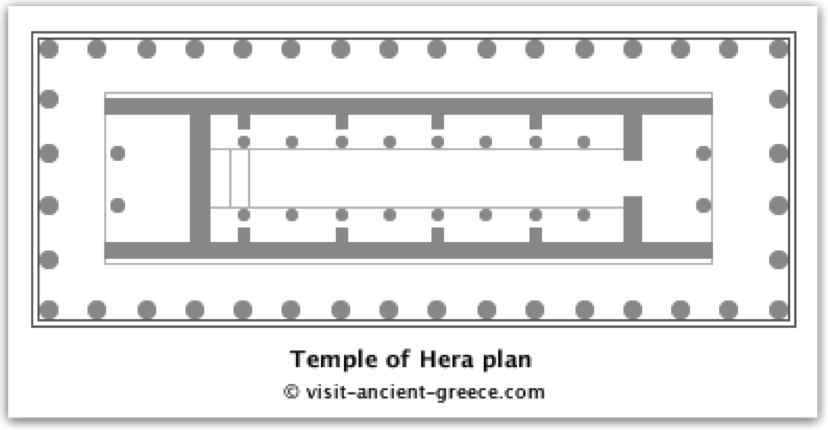Temple of Hera, Olympia
To find your page, see the list under Handouts and click the correct tab on the Archaeological site database.
Please edit the page properties (see here for instructions) to change the title to the name of the archaeological site you will be writing about, then replace the Italicised instructions below with your entry... If you want to know how to add e.g. additional images, podcasts, etc., please see this page. If copying from word, rather than using CTRL-V, please click the small "paste from word" icon (with a 'w') which neatens up the formatting.
Archaeological Development
The site first fell into disuse after the last games were held there in 393 AD. Floods from the river Alpheios, landslides and rockfalls from mount Cronos, and numerous earthquakes resulted in the site dissappearing under 3-4m layers of mud.
A frenchman first suggested the location of the site in the early 1700's. The first excavations took place in 1829 when the temple of zeus was explored. Then a German team conducted a comprehensive excavation between 1875 and 1881.
1900-1950 Excavation was continued in a more limited way by Dorpfeld between 1908 and 1929 but a new systematic excavation was begun in 1936 on the occasion of the 1936 Summer in Berlin under Emil Kunze and Hans Schleif . Their excavation focus on the area to the south of the stadium, the South stoa, bath complex and gymnasion.
1950 to present Between 1952 and 1966, Kunze and Schleif continued the excavation joined by architect Alfred Mallwitz. They excavated Pheidias' workshop, the Leonidaion and the north wall of the stadium. They also excavated the southeast section of the sanctuary and out of approximately 140 debris pits found many bronze and ceramic objects along with terracotta roof tiles.[1]
However, in August 2007 fierce forest fires ravaged many parts of the Pelopannese. There was a real danger of the fires destroying ancient Olympa. Onn account of the fires, most of the vegitation surrounding the site has been destroyed.
Gods/Heroes
The Temple was dedicated to the Goddess Hera. Hera was the wife of Zeus and queen of the ancient Greek gods, represented the ideal woman and was goddess of marriage and the family. However, she was perhaps most famous for her jealous and vengeful nature, principally aimed against the lovers of her husband and their illegitimate offspring. Hera herself was notable as one of the very few deities that remained faithful to her partner and she therefore came to symbolise monogamy and fidelity.
Ritual Activity
Sacrifice-
add text here as appropriate. Note that "shift + enter" inserts a line break without any paragraph spacing.
Dedications-
Pausanias mentions a multitide of votive offerings in the temple of Hera. He refers to an ivory adorned couch, the 'quiot of Iphitus', and a table on which the crowns for victors of the Herian games are displayed. The couch is said to have been a toy of Hippadameia. The 'quiot of Iphitus' has inscribed upon it the truce which the Eleans proclaim at the Olympic festivals. [2]
Festivals-
The Herian Games occured every four years, like the Olympic games. The ancient Herian Games was dedicated to the Goddess Hera. It was the first recorded and sanctioned women's athletic competition to be held in the stadium of Olympia. Pausanias (5.15.1-6.) dates the games to be as early as the 6th Centuary B.C., where he states (C 175 AD) that Hippodaemia gathered a group, known as the 16 women, and made them administrators of the Herean games out of gratitude for marriage to Pelops.[3] Other texts indicate that the "Sixteen Women" were peace-makers from Pisa and Elis and, because of their political competence, became administrators of the Heraea Games.[4]
Like the men's competition, The Herian Games originally consisted of foot races only. The Herian champions won olive crowns, cow or ox meat from the animals sacrificed to Hera, and the right to dedicate statues inscribed with their names or painted portraits of themselves on the collumns of Hera's temple.[5] It is still apparent where the portraits were attached to the temple, though the artwork itself has dissappeared.[6]
The women competed in three age age groups, on a track in the Olympic stadium that was 5/6 the length of the mens track. Pasaunias discribes their appearence for the race as "their hair hangs down, a tunic [chiton] reaches to a little above the knee, and they bear the right shoulder as far as the beast."[7]
Though the men competed nude and the women dressed, 'Chitons' were worn by men doing heavy physical work. Thus, the women competitors were dressed like men.
Rules and Regulations
None found
Other Activities
Earlier 20th Century scholars have used the evidence of Pausanias (v.17-20.3) and his account of the temple of Hera to characterise the sanctuary as a 'sort of storehouse' and a 'museumn.'[8]
By the time Pausanias visited Olympia around 173 CE, it had become a crowded, popular sanctuary. According to his account, the Atlis included two major temples, that of Zeus and the early 6th Centuary temple named by him as being dedicated to Hera.[9]
The temple is known to have held the 'Disk of Iphitos' on which the olympic truce was inscribed.
Additionally, in the Opisthodomos, one of the 3 chambers on the temple, stood the 'Chest of Kyoselos', made of wood, gold and Ivory, decorated with mythical scenes. It was where the Olympic victor's olive crowns were displayed.
Historical Significance
The Temple of Hera at Olympia was located North of the sacred precinct, the Altis. It was one of the earliest Doric Temple in Greece, as well as the oldest peripteral temple at that site, having a single row of collumns on all sides, posing the question that the location may have previously been the place for of worship for an older cult. [10] The temple was built in approximately 590 BC, but was destroyed by an earthquake in the early 4th century AD.
Layout Description
The temple measures 169ft by 63ft with the height of 50ft at the of the temple platform , 'the Stylobate.'[11] It was longer and narrower than the common architecture of the previous era, although the long preportions are a common feature of early Doric architecture.
Structure of the Temple
The temple was divided into three chambers: Pronaos, Cella and Opisthodomos. The Cella, which was entered through the Pronaos by a double door 2.9m wide, and was divided longitudinally by two rows of doric collumns.
On a pedestal at the end of the Cella stood the cult statue of Zeus and Hera, mentioned by Pausanias.[13] Zeus was depicted standing next to Hera who was seated on a throne. The Archaic stone head of Hera, recovered near the Heraion, and is displayed in the Olympia Archeological Museumn.
Who used the site, and where did they come from?
The Temple was erected around 590 BC., as a dedication by the Tiphylian Polis of Skillous, originally in honour of their main partron deity at Olympia, Zeus, which was later dedicated to Hera after the control pf Olympia was passed from Tiphylia to Elis in 580 B.C., or when the famous temple of Zeus was built.
Select Site Bibliography
Arafat, K.W. (1995) 'Pausanias and the Temple of Hera at Olympia' The Annual of the British School at Athens Vol. 90. pp. 461-473
Darling, J. K. (2004). 'Architecture of Greece.' Greenwood Publishing Group. pp. 195–197.
DesMarteau, L. (2005) 'The Heraea Games'. The History and Mythology of the Heraea Games and the Sixteen Women
Miron, D. (2004-5) [2007] 'The Heraia at Olympia: Gender and Peace'
AMERICAN JOURNALOF ANCIENT HISTORY volume 3-4. pp 1-33.
Olympia Greece Site. Accessed at http://www.olympia-greece.org/site.html
Scanlon, Thomas F. (2004) 'Games for Girls'. Ancient Olympics Guide.
Swaddling, Judith. "Women at the Heraia". Ancient Greek Olympics Gallery. Accessed: at http://www.bbc.co.uk/history/ancient/greeks/greek_olympics_gallery_06.shtml
Pausanias- http://www.perseus.tufts.edu/hopper/text?doc=Perseus:text:1999.01.0160 Translated by W.H.S. Jones, Litt.D., and H.A. Ormerod
Footnotes
1- Olympia Greece Site- http://www.olympia-greece.org/site.html
2- Pausanias 5.20.1.
3- Darling. (2004). 195–197.
4- Scanlon. (2004)
5- DesMarteau.(2005) 'The Heraea Games'.
6- Pausanias 5.15.1-6.
7- Swaddling. "Women at the Heraia". Ancient Greek Olympics Gallery. Accessed: at http://www.bbc.co.uk/history/ancient/greeks/greek_olympics_gallery_06.shtml
8- Pausanias 5.15.1-6.
9- Arafat (1995) 463.
10- Pausanias V.17-20.3.
11- Pausanias 516.1 xvi
12- Pausanias 5.16.1. xvi.
13- Pausanias V,17,1.
Location
Please add the location here. Also, search for it on Pelagios (click here) and add a link to "further information" about the place.
You might even want to embed a map to show it within the context of other archaeological sites from vici.org, like below. To find out how to do this, see the further instructions page.
Site Plan


